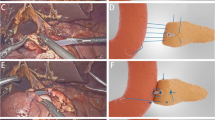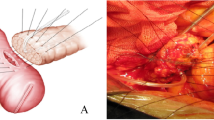Abstract
Background
To present a new pancreaticojejunostomy technique for laparoscopic pancreaticoduodenectomy (LPD) and to evaluate its safety and reliability.
Methods
The data of 120 patients who underwent LPD at a single centre from October 2017 to October 2019 were retrospectively analysed. Of these patients, 71 received continuous suture pancreaticojejunostomy, and 49 received “8-character” suture pancreaticojejunostomy for LPD. We compared and analysed the operation time, anastomosis time, and incidence of postoperative complications between the patients in the two groups.
Results
All operations were successfully performed, with no transfer to open surgery. The operation time and anastomosis time in the continuous suture group were lower than those in the “8-character” suture group (305.8 ± 60.7 min vs. 354.3 ± 69.1 min; 28.6 ± 6.3 min vs. 39.4 ± 11.9 min P < 0.001), and the postoperative hospital stay was also shorter (12.9 ± 3.8 days vs. 15.4 ± 5.8 days P < 0.05) in the continuous suture group. There was no significant difference in the pancreatic duct diameter or intraoperative blood loss between the two groups. There was also no significant difference in the incidence of a pancreatic fistula between the continuous suture group and the “8-character” suture group. The data of patients in the continuous suture group with pancreatic duct diameters < 3 mm and ≥ 3 mm were statistically analysed. There was no significant difference in the operation time, pancreaticojejunostomy time, postoperative hospital stay, or incidence of pancreatic fistula in the different pancreatic duct diameter groups.
Conclusions
Continuous suture of pancreaticojejunostomy in LPD is simple, safe, reliable, and rapid. This technique not only saves the anastomosis time but also suitable for pancreatic ducts < 3 mm.




Similar content being viewed by others
References
Gagner M, Pomp A (1994) Laparoscopic pylorus-preserving pancreatoduodenectomy. Surg Endosc 8:408–410
Ukkola O, Kervinen K, Salmela PI, von Dickhoff K, Laakso M, Kesäniemi YA (1993) Apolipoprotein E phenotype is related to macro- and microangiopathy in patients with non-insulin-dependent diabetes mellitus. Atherosclerosis 101:9–15
Palanivelu C, Senthilnathan P, Sabnis SC, Babu NS, Srivatsan GS, Anand VN, Nalankilli VP, Praveen RP, Parthasarathy R, Rajapandian S (2017) Randomized clinical trial of laparoscopic versus open pancreatoduodenectomy for periampullary tumours. Br J Surg 104:1443–1450
Wang M, Xu S, Zhang H, Peng S, Zhu F, Qin R (2017) Imbedding pancreaticojejunostomy used in pure laparoscopic pancreaticoduodenectomy for nondilated pancreatic duct. Surg Endosc 31:1986–1992
Croome KP, Farnell MB, Que FG, Reid-Lombardo KM, Truty MJ, Nagorney DM, Kendrick ML (2014) Total laparoscopic pancreaticoduodenectomy for pancreatic ductal adenocarcinoma: oncologic advantages over open approaches? Ann Surg 260(633–638):638–640
Tee MC, Kendrick ML, Farnell MB (2015) Laparoscopic pancreaticoduodenectomy: is it an effective procedure for pancreatic ductal adenocarcinoma? Adv Surg 49:143–156
Hakeem AR, Verbeke CS, Cairns A, Aldouri A, Smith AM, Menon KV (2014) A matched-pair analysis of laparoscopic versus open pancreaticoduodenectomy: oncological outcomes using Leeds Pathology Protocol. Hepatobiliary Pancreat Dis Int 13:435–441
Chen Y, Ke N, Tan C, Zhang H, Wang X, Mai G, Liu X (2015) Continuous versus interrupted suture techniques of pancreaticojejunostomy after pancreaticoduodenectomy. J Surg Res 193:590–597
Ji W, Shao Z, Zheng K, Wang J, Song B, Ma H, Tang L, Shi L, Wang Y, Li X, Song B, Zhang Y, ** G (2015) Pancreaticojejunostomy with double-layer continuous suturing is associated with a lower risk of pancreatic fistula after pancreaticoduodenectomy: a comparative study. Int J Surg 13:84–89
Yao G, Fan Y, Zhai J (2016) Continuous suturing with two anterior layers reduces post-operative complications and hospitalization time in pancreaticoenterostomy. BMC Gastroenterol 16:69
Han HJ, Choi SB, Lee JS, Kim WB, Song TJ, Suh SO, Kim YC, Choi SY (2011) Reliability of continuous suture of pancreaticojejunostomy after pancreaticoduodenectomy. Hepatogastroenterology 58:2132–2139
** WW, Xu XW, Mou YP, Zhou YC, Zhang RC, Yan JF, Zhou JY, Huang CJ, Lu C (2017) Laparoscopic pancreaticoduodenectomy: a report of 233 cases by a single team. Zhonghua Wai Ke Za Zhi 55:354–358
Adham M, Singhirunnusorn J (2012) Surgical technique and results of total mesopancreas excision (TMpE) in pancreatic tumors. Eur J Surg Oncol 38:340–345
Du Y, Wang J, Li Y, Ma H, Liu L, Zhu Y, Zhao W (2019) Clinical application of a modified pancreatojejunostomy technique for laparoscopic pancreaticoduodenectomy. HPB (Oxford) 21:1336–1343
Bassi C, Marchegiani G, Dervenis C, Sarr M, Abu HM, Adham M, Allen P, Andersson R, Asbun HJ, Besselink MG, Conlon K, Del CM, Falconi M, Fernandez-Cruz L, Fernandez-Del CC, Fingerhut A, Friess H, Gouma DJ, Hackert T, Izbicki J, Lillemoe KD, Neoptolemos JP, Olah A, Schulick R, Shrikhande SV, Takada T, Takaori K, Traverso W, Vollmer CR, Wolfgang CL, Yeo CJ, Salvia R, Buchler M (2017) The 2016 update of the International Study Group (ISGPS) definition and grading of postoperative pancreatic fistula: 11 years after. Surgery 161:584–591
Wente MN, Bassi C, Dervenis C, Fingerhut A, Gouma DJ, Izbicki JR, Neoptolemos JP, Padbury RT, Sarr MG, Traverso LW, Yeo CJ, Büchler MW (2007) Delayed gastric emptying (DGE) after pancreatic surgery: a suggested definition by the International Study Group of Pancreatic Surgery (ISGPS). Surgery 142:761–768
Koch M, Garden OJ, Padbury R, Rahbari NN, Adam R, Capussotti L, Fan ST, Yokoyama Y, Crawford M, Makuuchi M, Christophi C, Banting S, Brooke-Smith M, Usatoff V, Nagino M, Maddern G, Hugh TJ, Vauthey JN, Greig P, Rees M, Nimura Y, Figueras J, DeMatteo RP, Buchler MW, Weitz J (2011) Bile leakage after hepatobiliary and pancreatic surgery: a definition and grading of severity by the International Study Group of Liver Surgery. Surgery 149:680–688
Hallet J, Zih FS, Deobald RG, Scheer AS, Law CH, Coburn NG, Karanicolas PJ (2015) The impact of pancreaticojejunostomy versus pancreaticogastrostomy reconstruction on pancreatic fistula after pancreaticoduodenectomy: meta-analysis of randomized controlled trials. HPB (Oxford) 17:113–122
Peng L, Lin S, Li Y, **ao W (2017) Systematic review and meta-analysis of robotic versus open pancreaticoduodenectomy. Surg Endosc 31:3085–3097
Shrikhande SV, Sivasanker M, Vollmer CM, Friess H, Besselink MG, Fingerhut A, Yeo CJ, Fernandez-delCastillo C, Dervenis C, Halloran C, Gouma DJ, Radenkovic D, Asbun HJ, Neoptolemos JP, Izbicki JR, Lillemoe KD, Conlon KC, Fernandez-Cruz L, Montorsi M, Bockhorn M, Adham M, Charnley R, Carter R, Hackert T, Hartwig W, Miao Y, Sarr M, Bassi C, Büchler MW (2017) Pancreatic anastomosis after pancreatoduodenectomy: a position statement by the International Study Group of Pancreatic Surgery (ISGPS). Surgery 161:1221–1234
Cheng Y, Briarava M, Lai M, Wang X, Tu B, Cheng N, Gong J, Yuan Y, Pilati P, Mocellin S (2017) Pancreaticojejunostomy versus pancreaticogastrostomy reconstruction for the prevention of postoperative pancreatic fistula following pancreaticoduodenectomy. Cochrane Database Syst Rev 9:D12257
Wang M, Zhang H, Wu Z, Zhang Z, Peng B (2015) Laparoscopic pancreaticoduodenectomy: single-surgeon experience. Surg Endosc 29:3783–3794
Karagul S, Kayaalp C, Sumer F, Yagci MA (2018) Extramucosal pancreaticojejunostomy at laparoscopic pancreaticoduodenectomy. J Minim Access Surg 14:76–78
Cai Y, Luo H, Li Y, Gao P, Peng B (2019) A novel technique of pancreaticojejunostomy for laparoscopic pancreaticoduodenectomy. Surg Endosc 33:1572–1577
Olakowski M, Grudzińska E, Mrowiec S (2020) Pancreaticojejunostomy-a review of modern techniques. Langenbecks Arch Surg 405:13–22
Burch JM, Franciose RJ, Moore EE, Biffl WL, Offner PJ (2000) Single-layer continuous versus two-layer interrupted intestinal anastomosis: a prospective randomized trial. Ann Surg 231:832–837
Brodsky JT, Dadian N (1997) Single-layer continuous suture for gastrojejunostomy. Am Surg 63:395–398
Chen K, Pan Y, Liu XL, Jiang GY, Wu D, Maher H, Cai XJ (2017) Minimally invasive pancreaticoduodenectomy for periampullary disease: a comprehensive review of literature and meta-analysis of outcomes compared with open surgery. BMC Gastroenterol 17:120
Song KB, Kim SC, Lee W, Hwang DW, Lee JH, Kwon J, Park Y, Lee SJ, Park G (2020) Laparoscopic pancreaticoduodenectomy for periampullary tumors: lessons learned from 500 consecutive patients in a single center. Surg Endosc 34:1343–1352
Wellner UF, Küsters S, Sick O, Busch C, Bausch D, Bronsert P, Hopt UT, Karcz KW, Keck T (2014) Hybrid laparoscopic versus open pylorus-preserving pancreatoduodenectomy: retrospective matched case comparison in 80 patients. Langenbecks Arch Surg 399:849–856
Gupta D, Sharma U, Chauhan S, Sahu SA (2018) Improved outcomes of scar revision with the use of polydioxanone suture in comparison to polyglactin 910: a randomized controlled trial. J Plast Reconstr Aesthet Surg 71:1159–1163
Funding
This study was funding by the Department of Science & Technology, Xuzhou, Jiangsu, China (Grant Nos. KC18213, KC20054).
Author information
Authors and Affiliations
Corresponding authors
Ethics declarations
Disclosures
Hongqin Ma, Ji Wang, Li Liu, Yusheng Du, Wenxing Zhao, **nguo Zhu have no conflicts of interest or financial ties to disclose.
Additional information
Publisher's Note
Springer Nature remains neutral with regard to jurisdictional claims in published maps and institutional affiliations.
Supplementary Information
Below is the link to the electronic supplementary material.
Rights and permissions
About this article
Cite this article
Ma, H., Wang, J., Liu, L. et al. Clinical application of pancreatic-duct-jejunum end-to-side continuous suture anastomosis in total laparoscopic pancreaticoduodenectomy. Surg Endosc 36, 5366–5373 (2022). https://doi.org/10.1007/s00464-021-08920-1
Received:
Accepted:
Published:
Issue Date:
DOI: https://doi.org/10.1007/s00464-021-08920-1




